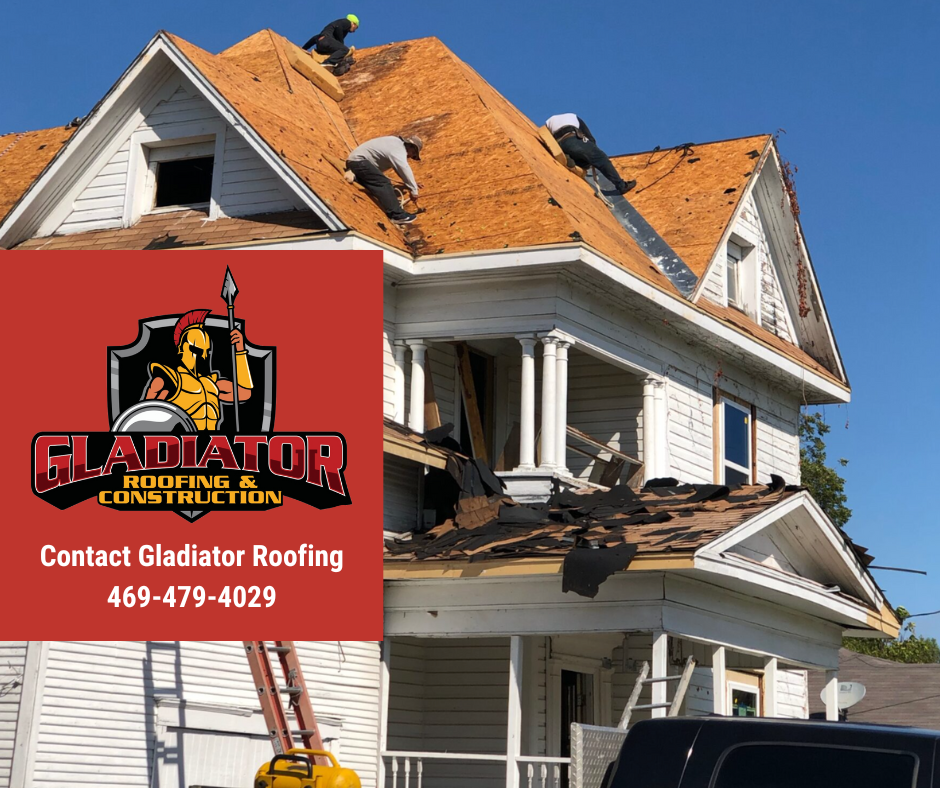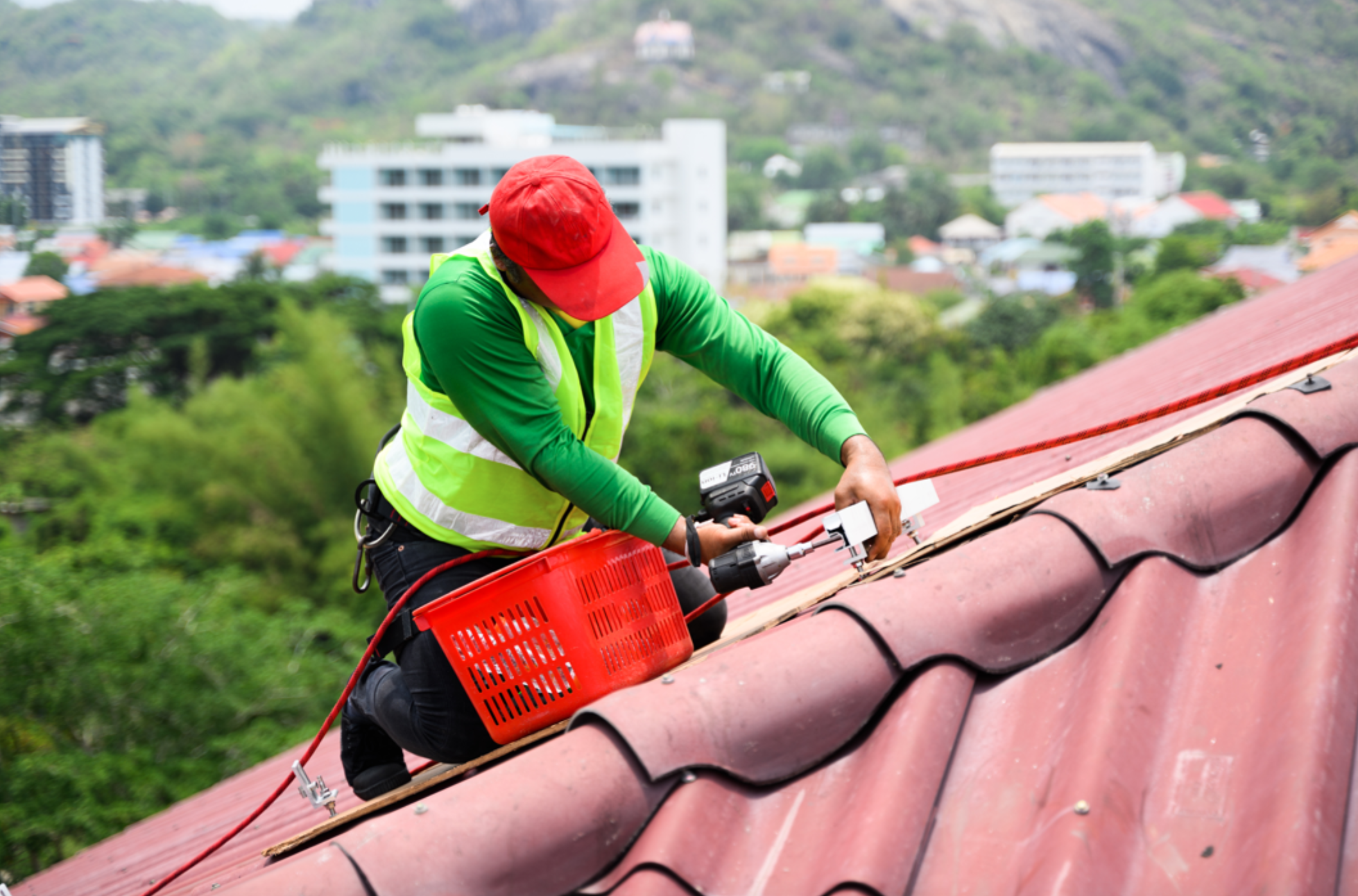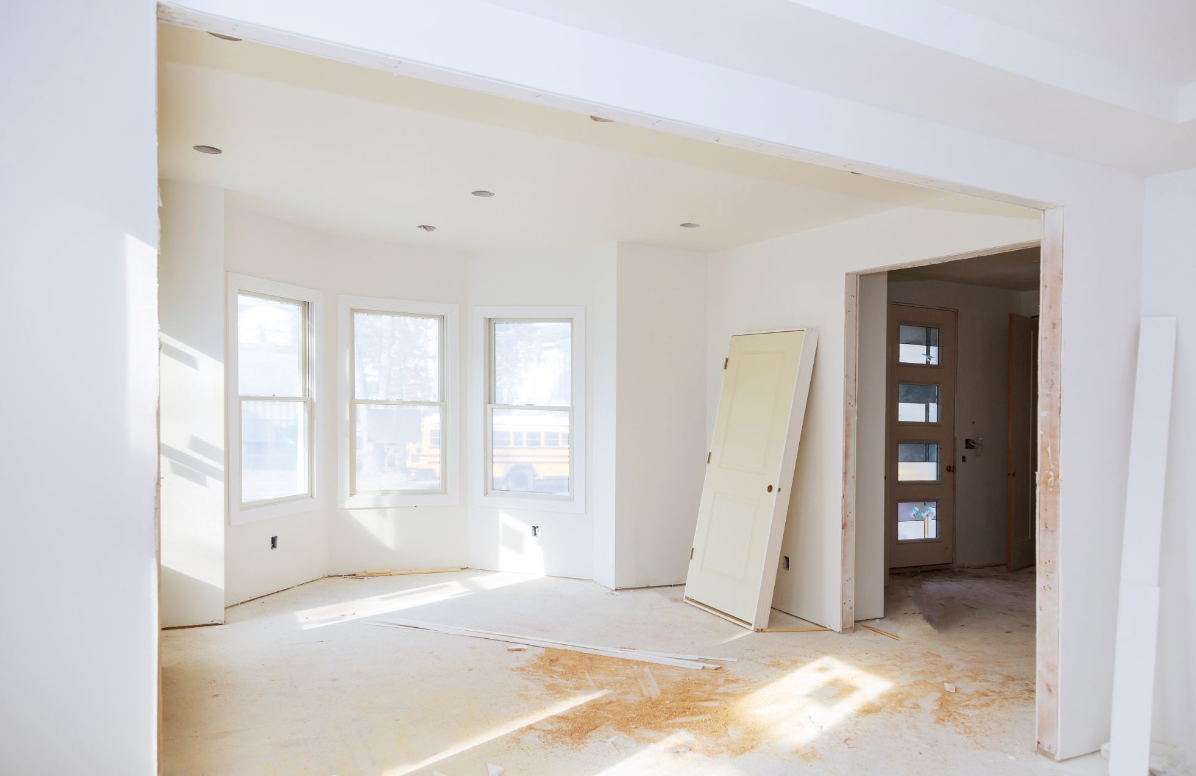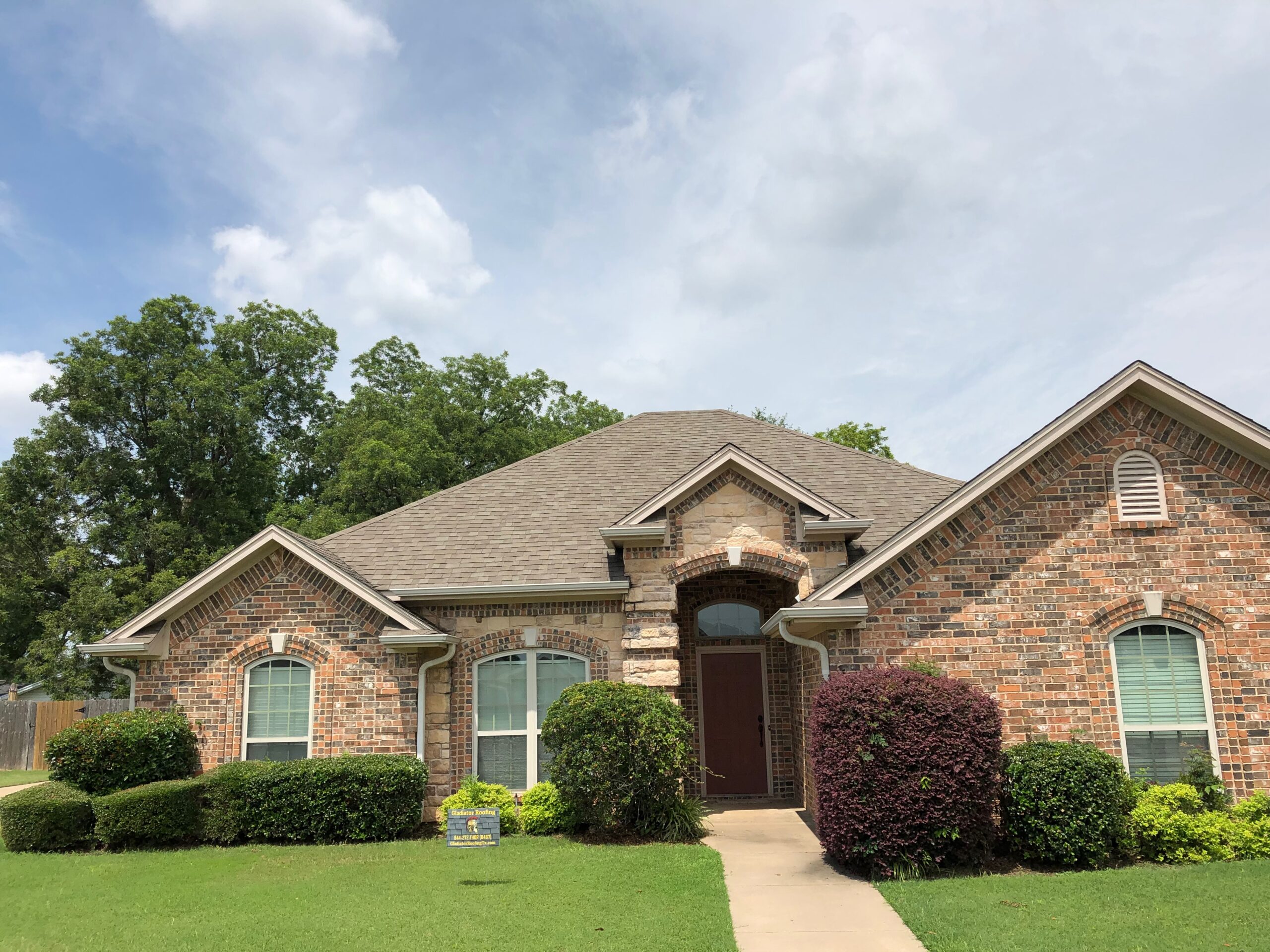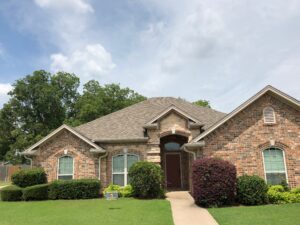Signs It's Time to Replace Your Gutters
Your gutters are essential for directing water away from your home, protecting it from potential water damage. But, over time, gutters can wear out and may need to be replaced.
Here are some potential signs indicating it's time to replace your gutters... 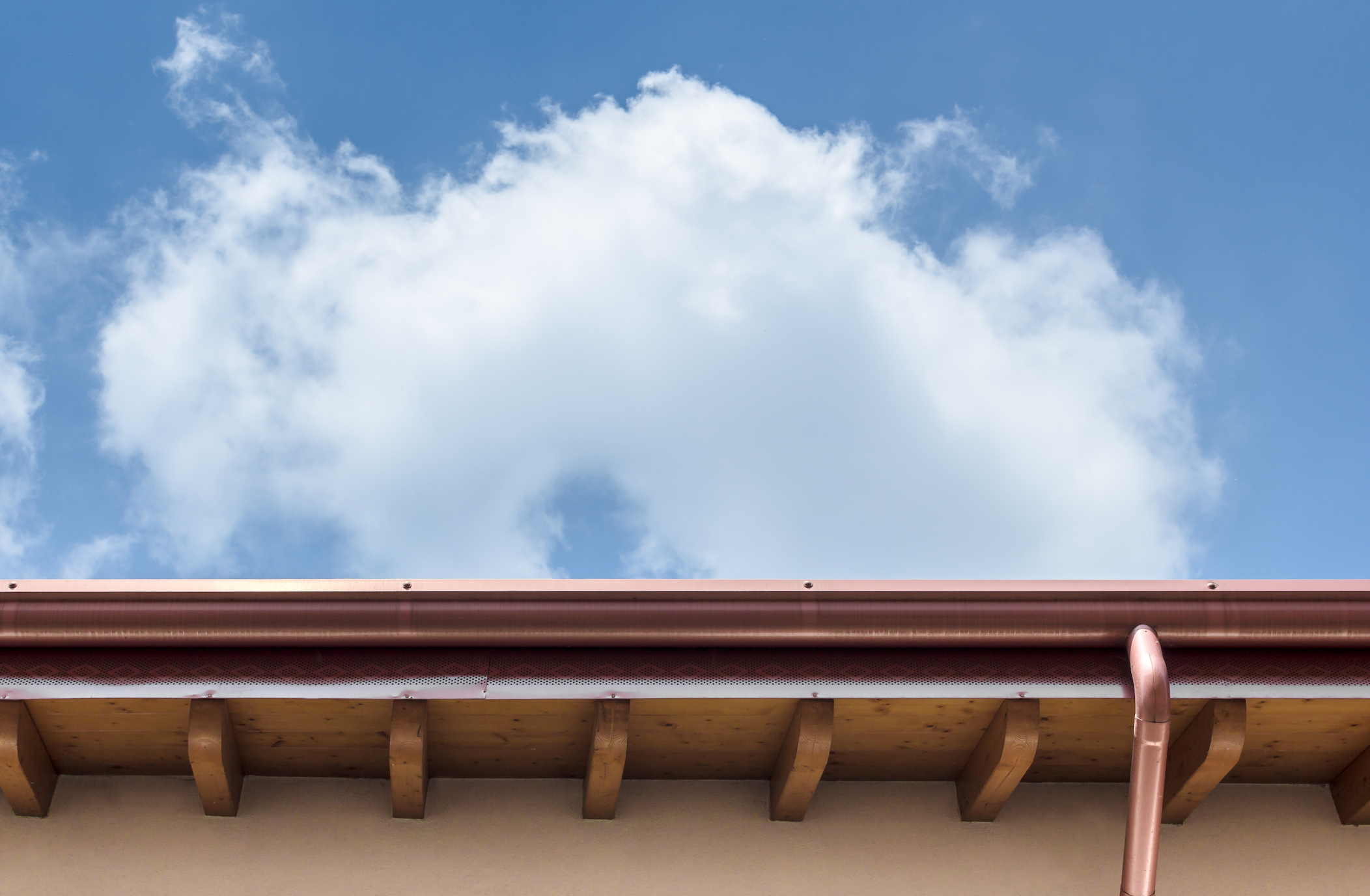
Persistent Leaks
If you notice water dripping from your gutters even after you've sealed the seams and joints, it’s a sure sign they’re past their prime. Leaks that won't go away suggest that your gutters are no longer doing their job properly. When this happens, it's time to consider replacing them to protect your home from water damage.
Visible Rust and Corrosion
Rust and corrosion are clear indicators that your gutters are deteriorating. If you spot rust spots, holes, or any signs of corrosion, it means the metal is weakening. This weakening compromises the structural integrity of your gutters, making them more prone to leaks and breaks.
Sagging Gutters
Gutters should be firmly attached to your house and maintain a consistent slope for proper drainage. If you notice any sections of your gutters sagging or pulling away from the roofline, it’s a major red flag. Sagging gutters can’t drain water effectively and can cause further damage.
Peeling Paint or Mold
Peeling paint or mold growth around your gutters or on your home’s exterior walls is a sign of water overflow or leakage. This usually occurs when gutters are clogged or not functioning properly. Addressing this issue by replacing your gutters can prevent further damage and keep your home looking its best.
Water Damage Marks
Water damage or staining on your home's fascia boards or siding indicates that water is escaping from the gutters. This can lead to serious structural problems if left unchecked. Replacing your gutters can help prevent further water damage and maintain your home’s integrity.
The most important signs homeowners shouldn't ignore when it comes to replacing your gutter.
Frequent Clogs
If your gutters are constantly clogged despite regular cleaning, it might be due to their design or age. Older gutters may not handle debris as efficiently as newer systems, leading to frequent blockages. Upgrading to new gutters can save you time and hassle in the long run.
Cracks and Splits
Visible cracks or splits in your gutters are signs that they are deteriorating. Even small cracks can grow larger over time, allowing water to seep through and cause damage to your home's foundation and landscaping.
Eroded Landscaping
Eroded or waterlogged areas in your landscaping can be a sign of overflowing gutters. Gutters that don’t function correctly can cause water to pool around your home, damaging plants and soil.
Separation at the Seams
Sectional gutters can start to separate at the seams over time. If you notice the joints coming apart frequently, it indicates that your gutters are failing. Seam separation can lead to leaks and water damage, so it’s important to replace them to ensure proper function.
Replacing Your Gutters
Regularly inspecting your gutters can help you catch these signs early and prevent extensive damage to your home. If you notice any of these issues, it’s time to consider replacing your gutters to keep your home safe and sound.
For professional gutter replacement services, visit Gladiator Roofing.
Transforming Your Basement: Remodeling Ideas for Extra Living Space
Basements often hold untapped potential for expanding your living space. Whether you need an extra bedroom, a home office, or a cozy entertainment area, a well-planned basement remodel can enhance both the functionality and enjoyment of your home.
Here are some creative ways to turn your basement into a family-fun space everyone loves...
Create a Cozy Family Room
Turn your basement into a comfortable family room where everyone can relax. Add plush seating, warm lighting, and entertainment features like a large-screen TV or a gaming console. Consider installing soundproofing materials to keep the noise contained.
Design a Home Office
With more people working from home, a quiet and dedicated workspace is essential. Convert your basement into a home office with built-in desks, ample storage, and good lighting. Choose calming colors to create a productive environment.
Add a Guest Suite
If you frequently host guests, consider turning your basement into a guest suite. Include a bedroom, bathroom, and small sitting area to provide privacy and comfort. This can also be a great option for multi-generational living.
Set Up a Home Gym
Skip the crowded gyms and create your own fitness haven in your basement. Install rubber flooring, mirrors, and essential workout equipment. Ensure good ventilation and lighting to keep the space inviting.
Build a Home Theater
Transform your basement into a home theater for an immersive movie-watching experience. Invest in a high-quality projector, comfortable seating, and soundproofing. Add a popcorn machine for an authentic touch.
Remodeling your basement can create a wonderful new space for you and your family to enjoy.
Establish a Playroom for Kids
A basement playroom can keep toys and games contained while providing a fun space for kids to play. Add colorful storage solutions, a craft area, and soft flooring to make it safe and enjoyable.
Design a Hobby or Craft Room
If you have hobbies that require space and storage, like crafting or woodworking, consider dedicating your basement to these activities. Install workbenches, storage cabinets, and proper lighting to create an inspiring space.
Create a Wine Cellar or Bar
For wine enthusiasts or those who love entertaining, a wine cellar or bar area can be a fantastic addition. Install wine racks, a tasting table, and ambient lighting to create a sophisticated atmosphere.
Develop a Multi-Purpose Space
Combine several functions into one flexible space. A basement can house a guest bed, office nook, and entertainment area all in one. Use creative room dividers and multifunctional furniture to keep the space organized.
Enhance with Smart Home Features
Integrate smart home technology into your basement remodel for added convenience. Control lighting, temperature, and entertainment systems with a touch of a button to create a modern and efficient living area.
…
Transforming your basement into a functional and enjoyable living area can significantly enhance your home's value and usability. Whether you need additional living space or a dedicated area for hobbies and relaxation, the possibilities are endless.
Learn more about remodeling services to help bring your vision to life.
How to Choose the Right Roofing Material for Texas Weather
Choosing the right roofing material is crucial for ensuring the longevity and durability of your roof, especially in a state like Texas where weather conditions can be extreme and varied.
From intense heat to hail storms and heavy rain, Texas weather demands roofing materials that can withstand these challenges…
Understanding Texas Weather Challenges
Texas weather can be harsh and unpredictable. Some of the common weather challenges include:
- Intense Heat: Texas summers can be extremely hot, with temperatures often exceeding 100 degrees Fahrenheit. This intense heat can cause roofing materials to expand and contract, leading to potential damage over time.
- Hail Storms: Texas is known for severe hail storms, which can cause significant damage to roofs by creating dents, cracks, and even holes.
- Heavy Rain and Storms: Heavy rainfall and strong winds during storms can lead to water damage and roof leaks.
- Hurricanes: Coastal areas in Texas are susceptible to hurricanes, which bring torrential rain, strong winds, and flying debris that can severely damage roofs.
Given these weather challenges, it’s essential to choose roofing materials that offer durability, energy efficiency, and resistance to severe weather conditions.
Choosing the best roofing material is essential for withstanding Texas weather challenges.
Best Roofing Materials for Texas Weather
- Asphalt Shingles
- Pros: Asphalt shingles are popular due to their affordability, ease of installation, and variety of styles. They are also relatively durable and can withstand moderate hail and wind.
- Cons: They may not be the best option for extreme heat, as they can become brittle over time and may require more frequent replacement.
- Metal Roofing
- Pros: Metal roofs are highly durable and can withstand extreme weather conditions, including high winds, hail, and intense heat. They are also energy-efficient, reflecting much of the sun’s heat and reducing cooling costs.
- Cons: Metal roofing can be more expensive upfront compared to other materials, and installation requires skilled professionals.
- Tile Roofing
- Pros: Tile roofs, made from clay or concrete, are excellent for hot climates as they provide good insulation and are resistant to fire. They are also highly durable and can last for several decades.
- Cons: Tile roofing is heavy and may require additional structural support. It can also be more expensive and time-consuming to install.
- Slate Roofing
- Pros: Slate is one of the most durable roofing materials available, with a lifespan of over 100 years. It is highly resistant to hail and fire, and it provides excellent insulation against heat.
- Cons: Slate roofing is very heavy and requires significant structural support. It is also one of the most expensive roofing materials and requires specialized installation.
- Synthetic Roofing Materials
- Pros: Synthetic roofing materials, such as synthetic slate or rubber shingles, offer durability and weather resistance similar to natural materials but at a lower cost and weight. They are also easier to install.
- Cons: The quality and durability can vary between manufacturers, so it’s important to choose a reputable brand.
Factors to Consider When Choosing Roofing Materials
- Durability: Select materials that can withstand the specific weather conditions in your area. Metal and slate are known for their durability against hail and high winds, while tile and synthetic materials offer good resistance to heat.
- Energy Efficiency: In a hot climate like Texas, energy-efficient roofing materials can help reduce cooling costs. Metal and tile roofs are excellent at reflecting heat and providing good insulation.
- Cost: Consider both the initial cost of the roofing material and the long-term maintenance and replacement costs. While some materials may be more expensive upfront, they can offer better durability and lower maintenance costs over time.
- Aesthetics: Choose a roofing material that complements the style and architecture of your home. Many materials come in a variety of colors and styles to match your preferences.
- Installation and Maintenance: Some roofing materials require specialized installation and maintenance. Ensure you choose a material that you can maintain properly and that you have access to skilled professionals for installation.
Professional Assistance
Selecting the right roofing material for Texas weather involves balancing durability, energy efficiency, cost, and aesthetics.
For expert advice and professional roofing services, contact Gladiator Roofing and Construction. Our team can help you select and install the best roofing material to withstand Texas weather and keep your home safe and comfortable.
Protecting Your Roof During Hurricane Season in Texas
Living in Texas means being prepared for hurricane season, especially when it comes to safeguarding your roof. High winds and heavy rains can cause significant damage, but with the right precautions, you can keep your roof in top shape...
Inspect and Repair Any Damage
Before hurricane season kicks in, give your roof a thorough once-over. Look for missing shingles, cracks, or any signs of wear and tear. Fixing these issues early can prevent them from becoming major problems when the storms hit. If you're unsure about your roof's condition, consider hiring a professional to assess and handle any necessary repairs.
Reinforce Your Roof
Strengthen your roof with additional reinforcements like hurricane straps or clips. These connect your roof to the walls of your house, giving it extra stability during strong winds. Reinforcements can make a significant difference in keeping your roof secure during a hurricane.
Clean Gutters and Downspouts
Clear out your gutters and downspouts to ensure they can handle heavy rainfall. Clogged gutters can lead to water pooling on your roof, increasing the risk of leaks and damage. Keeping them clean helps rainwater flow away from your home, protecting your roof and foundation.
Proper preparation and maintenance are essential for ensuring your roof withstands hurricane season in Texas.
Trim Overhanging Branches
Overhanging branches can be a major hazard during a hurricane. High winds can break branches and send them crashing onto your roof. Trim any branches that are too close to your house to minimize this risk.
Secure Loose Items
Patio furniture, garden tools, and other loose items can become dangerous projectiles in a hurricane. Secure or store these items safely before a storm to prevent them from causing damage to your roof and home.
Consider Impact-Resistant Shingles
If you’re planning to replace your roof or make major repairs, think about using impact-resistant shingles. These shingles are designed to withstand high winds and flying debris, offering extra protection for your roof.
Maintain Proper Attic Ventilation
Good attic ventilation helps balance temperature and moisture levels, reducing the risk of mold and other issues. Make sure your attic is well-ventilated to keep your roof in good condition during hurricane season.
Schedule Regular Maintenance
Regular maintenance by a roofing professional can help spot potential problems before they escalate. Schedule routine inspections and maintenance to keep your roof in the best shape possible.
Prepare an Emergency Kit
An emergency kit with essentials like tarps, nails, a hammer, and basic tools can be a lifesaver if your roof gets damaged during a storm. Having these items on hand allows you to make temporary repairs and protect your home.
Know Your Insurance Policy
Review your homeowner's insurance policy to understand your coverage for hurricane damage. Make sure you have adequate protection and know the steps to take if you need to file a claim.
Professional Assistance
By taking these proactive steps, you can help ensure your roof withstands the challenges of hurricane season in Texas.
What to Expect During a Roof Inspection: A Step-by-Step Guide
Getting a roof inspection can feel a bit daunting if you don't know what to expect. No worries! Here’s everything you could expect to happen during a routine roof inspection…
Initial Consultation
Your roof inspection starts with an initial chat. The inspector will ask about any concerns you have and gather some background on your roof's history. This helps them focus on specific areas that might need extra attention.
Exterior Inspection
Next up, the inspector will take a good look at the outside of your roof. They’ll be checking:
- Shingle Condition: Are any shingles missing, cracked, or curling?
- Flashing and Seals: Are the seals around chimneys and vents watertight?
- Gutters and Downspouts: Are the gutters working properly and free of clogs?
- Roof Penetrations: Are there any signs of leaks around roof projections?
Interior Inspection
The inside of your home is just as important. The inspector will head to the attic to check:
- Attic Ventilation: Is there enough airflow to prevent moisture buildup?
- Insulation: Is the insulation dry and free from mold?
- Structural Issues: Is there any damage to the roof’s framework?
Everything you need to know about roof inspection and how professionals fix common problems.
Detailed Documentation
Throughout the inspection, the inspector will take notes and photos. This documentation helps create a clear picture of your roof's condition and any issues that need addressing.
Report and Recommendations
After the inspection, you'll get a detailed report. This report includes:
- Condition Assessment: A summary of your roof’s health.
- Repair Recommendations: Specific advice on what repairs or maintenance are needed.
- Cost Estimates: An idea of how much the repairs might cost.
Follow-Up
You might have questions after reading the report, and that's perfectly normal. A follow-up meeting is a great opportunity to discuss the findings and plan any necessary repairs.
Common Roof Problems Found During Inspections
During a roof inspection, several common issues might be discovered, including:
- Leakage and Water Damage: Signs of water intrusion, such as stains on ceilings or walls.
- Mold and Mildew: Indications of mold growth in the attic or other areas.
- Sagging Roof: Structural weaknesses that cause parts of the roof to sag.
- Damaged or Missing Shingles: Shingles that need replacement to protect the roof.
How Professionals Fix These Issues
Professional roofers use various methods to address the common problems found during inspections:
Leakage and Water Damage: Professionals will locate the source of the leak and repair it, which may involve replacing damaged shingles, fixing flashing, or sealing around roof penetrations. Interior water damage will be addressed by repairing ceilings and insulation affected by the leak.
Mold and Mildew: To tackle mold and mildew, roofers ensure proper attic ventilation and may replace moldy insulation. They will also treat affected areas with mold remediation solutions to prevent future growth.
Sagging Roof: Addressing a sagging roof involves reinforcing the roof’s structural elements. This might include adding support beams or rafters to strengthen the weakened areas.
Damaged or Missing Shingles: Professionals will replace damaged or missing shingles to restore the roof’s integrity and prevent leaks. They will also check the underlying roof structure to ensure there’s no additional damage.
Book a Roof Inspection TODAY!
Regular roof inspections are key to keeping your home in top shape. They help catch small issues before they become big problems, saving you time and money in the long run.
Learn more about roof inspections or schedule your own.
What is a TPO Roof & Why is it an Excellent Choice for Flat Roofs?
Thermoplastic Olefin (TPO) roofing has become a popular choice for flat roofs due to its durability, energy efficiency, and cost-effectiveness. Here’s why…
Understanding TPO Roofing
TPO roofing is a single-ply membrane made from a blend of polypropylene and ethylene-propylene rubber. This roofing material is designed to combine the durability of rubber with the performance benefits of hot-air weldable seams. TPO roofs are typically white or light-colored, which helps reflect sunlight and reduce heat buildup inside buildings.
Key Benefits of TPO Roofing
- Energy Efficiency: TPO roofing membranes are highly reflective, which can significantly reduce cooling costs by reflecting UV rays and keeping the building cooler. This energy efficiency makes TPO an environmentally friendly option.
- Durability and Longevity: TPO roofs are resistant to dirt, mold, and punctures, making them a durable option for commercial and residential buildings. They can withstand extreme weather conditions and have a long lifespan.
- Cost-Effectiveness: Compared to other roofing materials, TPO is relatively affordable. It offers excellent performance at a lower cost, making it a cost-effective solution for flat roofs.
- Easy Installation: TPO membranes are lightweight and flexible, which makes them easier to install compared to other roofing systems. This can reduce labor costs and installation time.
- Seam Strength: The hot-air weldable seams of TPO roofing provide superior strength and durability, reducing the risk of leaks and water damage.
TPO roofing is an efficient, durable, and cost-effective solution for flat roofs.
Why TPO is Ideal for Flat Roofs
Flat roofs present unique challenges that TPO roofing can effectively address. The seamless nature of TPO membranes helps prevent water pooling and leaks, which are common issues with flat roofs. Additionally, the reflective surface of TPO roofing reduces the heat island effect, which is particularly beneficial for urban areas with flat-roofed buildings.
Environmental Impact of TPO Roofing
One of the standout features of TPO roofing is its positive impact on the environment. The energy efficiency of TPO roofs not only helps reduce energy bills but also lessens the overall carbon footprint of a building. By reflecting sunlight and minimizing heat absorption, TPO roofs help lower the demand for air conditioning, leading to less energy consumption and fewer greenhouse gas emissions.
TPO roofing materials are also often recyclable, contributing to a reduction in waste, and making buildings more sustainable.
Maintenance and Care
Maintaining a TPO roof is relatively straightforward. Regular inspections and cleaning can help extend the lifespan of the roof. It's essential to address any minor issues promptly to prevent them from becoming significant problems. TPO roofs require less maintenance compared to other roofing materials, making them a hassle-free option for building owners.
Interested in TPO Roofing?
TPO roofing is a fantastic option for flat roofs thanks to its energy efficiency, durability, and affordability. It's easy to install and can handle all kinds of weather, making it a practical and reliable choice for your roofing needs.
Learn more about TPO roofing and other roofing services.
Why a Metal Roof Could Be the Best Investment for Your DFW Home
When it's time to replace your roof, picking the right material is vital. You want something that's durable, energy-efficient, and offers good value for your money. Metal roofing is a fantastic option that ticks all these boxes and more.
Exceptional Durability and Longevity Make Metal Roofs a Wise Choice
Metal roofs are known for their incredible durability and long life span. Unlike traditional asphalt shingles, which typically last 20 to 30 years, metal roofs can last 40 to 70 years or even longer. This means you won't have to worry about replacing your roof anytime soon. Metal roofs can also handle extreme weather conditions like heavy rain, snow, high winds, and even hail, making them a reliable choice no matter where you live.
Energy Efficiency and Cost Savings
One of the standout benefits of metal roofs is their energy efficiency. They reflect solar heat, which can help keep your home cooler during the hot summer months and reduce your cooling costs by up to 25%. Many metal roofs come with special coatings that enhance their reflective properties, further boosting energy savings and reducing your environmental footprint.
Environmental Benefits of Metal Roofing
If you’re looking for an eco-friendly option, metal roofs are a great pick. They’re often made from recycled materials and are 100% recyclable at the end of their life span. This helps reduce landfill waste and conserves natural resources. Plus, because they last so long, they don’t need to be replaced as often, which means fewer materials are used over time.
Discover the long-lasting, energy-efficient, and low-maintenance benefits of metal roofs for your home.
Low Maintenance Requirements
Compared to other roofing materials, these require minimal maintenance. Metal roofs are resistant to common issues like mold, mildew, and insect infestations. Routine maintenance typically involves periodic inspections and minor repairs, ensuring that homeowners spend less time and money on upkeep. This low maintenance requirement adds to the overall cost-effectiveness of metal roofing.
Enhanced Safety Features
Safety is another significant advantage of metal roofing. Metal roofs are non-combustible, providing a high level of fire resistance. This is particularly beneficial in areas prone to wildfires. The added layer of safety can also lead to lower home insurance premiums, providing additional financial benefits to homeowners.
Aesthetic Versatility
Modern metal roofs are available in a wide range of styles, colors, and finishes. This aesthetic versatility allows homeowners to choose a look that complements their home's architectural style. Whether you prefer the sleek, contemporary appearance of standing seam panels or the classic look of metal shingles that mimic traditional roofing materials, there is a metal roofing option to suit your taste.
Increased Property Value
Investing in a metal roof can also boost your home’s resale value. Potential buyers appreciate the benefits of metal roofing, such as its durability, low maintenance, and energy efficiency. This can make your home more attractive on the market and could even help you sell it for a higher price.
Benefits of a Metal Roof at a Glance
- Durability and Longevity: Lasts 40-70 years, highly resistant to weather conditions.
- Energy Efficiency: Reflects solar heat, reduces cooling costs by up to 25%.
- Environmental Impact: Made from recycled materials, 100% recyclable.
- Low Maintenance: Resistant to mold, mildew, and insects; minimal upkeep.
- Safety: Non-combustible, high fire resistance.
- Aesthetic Options: Wide range of styles, colors, and finishes.
- Property Value: Increases home resale value, attractive to buyers.
Investing in a Metal Roof Offers Numerous Long-Term Benefits
Investing in a metal roof offers homeowners numerous benefits, including exceptional durability, energy efficiency, low maintenance, enhanced safety, aesthetic versatility, and increased property value.
Learn more about metal roofs or roof replacements.
Modern Home Remodeling Trends for Texas Homes in 2024
Could your house use a makeover? With new trends emerging like open-concept living spaces and more modern designs and pallets - it’s a great time to transform your current home into your dream house.
Here are the trends we’re seeing…
Sustainable and Eco-Friendly Materials
Homeowners are increasingly choosing sustainable materials like reclaimed wood, recycled metal, and eco-friendly insulation. These materials not only help reduce environmental impact but also offer unique aesthetic appeal, making them both beautiful and responsible choices.
Smart Home Integration
Smart home technology is becoming a staple in modern renovations. From smart thermostats and lighting systems to advanced security features, integrating these technologies enhances convenience, safety, and energy efficiency. Homeowners can control various aspects of their homes through mobile apps or voice commands, creating a seamlessly connected living environment.
Open-Concept Living Spaces
Open-concept designs continue to be popular, promoting a sense of spaciousness and better flow between different areas of the home. By removing unnecessary walls, homeowners can create larger, more versatile spaces that are perfect for both entertaining and everyday living.
The latest home remodeling trends for Texas homes in 2024 offer a blend of modern aesthetics and practical functionality.
Biophilic Design
Biophilic design incorporates natural elements into home interiors, creating a connection with nature. This trend includes features like large windows for natural light, indoor plants, and water elements. Biophilic design not only enhances aesthetic appeal but also contributes to mental well-being by creating a calming and rejuvenating environment.
Multi-Functional Spaces
With the rise of remote work, creating multi-functional spaces is essential. Rooms that can serve as home offices, gyms, or guest rooms are highly valued. Flexible furniture and thoughtful design allow these spaces to adapt to various needs, maximizing the functionality of every square foot.
Luxury Bathrooms
Transforming bathrooms into luxurious spa-like retreats is a major trend. Features such as freestanding tubs, rain showers, and high-end finishes can turn a regular bathroom into a personal oasis. This trend emphasizes relaxation and comfort, providing homeowners with a sanctuary to unwind.
Energy-Efficient Upgrades
Energy efficiency remains a priority for many homeowners. Upgrades such as solar panels, energy-efficient windows, and improved insulation not only reduce utility bills but also increase the home's value. These eco-friendly improvements are both practical and environmentally responsible.
Outdoor Living Spaces
Creating outdoor living areas that function as extensions of the indoor space is becoming increasingly popular. Outdoor kitchens, fire pits, and comfortable seating areas make outdoor spaces more usable and enjoyable. This trend encourages spending more time outdoors, enhancing the overall living experience.
Bold Colors and Patterns
While neutral tones have been popular in recent years, 2024 is seeing a shift towards bold colors and patterns. Accent walls, vibrant tiles, and statement pieces add personality and character to home designs, allowing homeowners to express their unique style.
Minimalist Design
Minimalism continues to be a favorite, focusing on clean lines, uncluttered spaces, and functional furniture. This trend emphasizes quality over quantity, creating a serene and organized living environment that is both stylish and practical.
Transform Your Home with the Latest Remodeling Trends of 2024
By incorporating these top home remodeling trends for 2024, you can create a modern, stylish, and functional living space that meets your needs and reflects your personal taste. Whether you're planning a minor update or a major renovation, staying ahead of these trends can add significant value to your property.
Ready to transform your Texas home? Let’s start building your dream house today!
The Importance of Proper Roof Ventilation in DFW, Texoma & Hill Country Areas
In the DFW, Texoma, and Hill Country areas, proper roof ventilation is crucial for maintaining the health and longevity of your home by regulating temperature, preventing moisture buildup, and protecting your roof structure.
Temperature Regulation
It’s important to protect yourself from the summertime heat in these areas, which is exactly what proper roof ventilation does. It helps the hot air to escape allowing the air conditioning to work more effectively - reducing the strain on your HVAC system. Not only does this keep your home and attic cooler to create a much-needed escape from the summer heat, but it also lowers your energy bills and reduces your carbon footprint.
Moisture Control
Moisture buildup can cause serious issues, especially in humid areas. Proper ventilation prevents condensation from forming in your attic, which can lead to mold growth and structural damage. Ensuring that your roof has adequate ventilation helps keep moisture levels in check, protecting your home from potential damage.
Prolonging Roof Life
Without proper ventilation, the heat and moisture trapped in your attic can deteriorate your roofing materials over time. This can lead to shingles cracking, warping, or rotting. By maintaining a well-ventilated roof, you can extend the lifespan of your roofing materials, saving you money on repairs and replacements in the long run.
Preventing Ice Dams
In the colder months, proper roof ventilation is vital for preventing ice dams, which occur when warm air from your home melts the snow on your roof and refreezes at the eaves. This can cause water to back up under your shingles, leading to leaks and water damage. Proper ventilation helps maintain a consistent roof temperature, preventing the formation of ice dams.
Proper roof ventilation is crucial in the DFW, Texoma, and Hill Country areas for maintaining home health and longevity.
Signs of Poor Ventilation
Knowing the signs of poor roof ventilation can help you address issues before they cause significant damage. Look out for:
- Excessive heat in your attic
- Visible mold or mildew
- Warped or damaged shingles
- High energy bills
- Ice dams forming on your roof
If you notice any of these signs, it may be time to evaluate and improve your roof ventilation system.
Types of Roof Ventilation
There are several types of roof ventilation systems to consider:
- Ridge Vents: Installed at the peak of the roof, allowing hot air to escape.
- Soffit Vents: Located under the eaves, allowing fresh air to enter the attic.
- Gable Vents: Installed on the gable ends of the house, providing cross ventilation.
- Powered Attic Vents: Electric or solar-powered fans that actively remove hot air from the attic.
Looking for an Expert
Choosing the right type of ventilation for your home depends on your roof design and the climate in your area. It’s essential to consult with a professional to determine the best ventilation solution for your home.
Proper roof ventilation is a critical aspect of home maintenance in the DFW, Texoma, and Hill Country areas. It enhances comfort, protects your roof, and improves energy efficiency.
Learn more about maintaining proper roof ventilation and other roofing services.
Navigating Severe Storm Season in Texas: Protecting Your Roof from Wind and Hail Damage
As severe storm season intensifies, the risk of wind and hail damage to roofing becomes a major concern for homeowners. Understanding how to safeguard your roof can prevent costly repairs and ensure your home remains secure and dry.
Recognizing the Risk
During severe storms, roofs face significant vulnerability to damage caused by high winds and hail. Wind possesses the strength to lift or even remove shingles entirely, leaving the underlying decking exposed to additional harm from rain and accumulated debris. This exposure can lead to further structural damage and potential leaks.
Hail presents a different but equally damaging threat by potentially puncturing the roofing material or removing the granular surface of shingles. When the granular coating is stripped away, the shingles' ability to repel water is greatly weakened. This reduces the overall integrity of the roof and increases the risk of water infiltrating the home. For homeowners, understanding and addressing these risks is crucial to maintaining the effectiveness of their roofing system during the stormy season.
Pre-Storm Preparation
Here are some things you should look for to ensure your roof is in optimal condition to withstand severe weather:
- Gutter Maintenance: Clean and check gutters and downspouts regularly to ensure they are not clogged with debris, which can cause water to pool and damage your roof.
- Flashing Checks: Inspect flashing around vents, chimneys, and skylights to ensure it is sealed and in good condition to prevent water leaks.
- Trim Overhanging Branches: Cut back any tree branches that hang close to or over your roof to prevent them from breaking off and damaging shingles during a storm.
- Secure Loose Items: Ensure that any antennas, satellite dishes, or other roof-mounted equipment are securely fastened to prevent them from becoming airborne and causing damage during high winds.
- Debris Removal: Remove any debris from the roof that could be tossed around by the wind, potentially causing damage to the roof surface.
Taking these steps before a storm can significantly reduce the risk of damage to your roof, potentially saving you from costly repairs later.
Ensuring Roof Integrity During Severe Weather in Texas
During the Storm
Regular updates from weather services can provide crucial information about the storm’s progress, helping you to make informed decisions to protect your property.
Post-Storm Assessment
After a severe storm, it's crucial to conduct a comprehensive assessment of your roof to catch any potential damage early. Here’s a checklist for a post-storm roof inspection:
- Shingle Inspection: Look for any missing, lifted, or damaged shingles that may have been affected by high winds or hail.
- Hail Damage: Check for dents or pockmarks in the shingles caused by hail impacts, which can compromise the roof's integrity.
- Debris Check: Clear any debris that has accumulated on the roof, as this can retain moisture and degrade roofing materials over time.
- Gutter Evaluation: Ensure gutters and downspouts are intact and clear of leaves and debris to prevent water buildup and ensure proper drainage.
- Interior Inspection: Check the attic and ceilings for any signs of water infiltration, which could indicate roof leaks.
Promptly addressing these issues can prevent further damage and costly repairs in the future.
Professional Help
Sometimes, the extent of roof damage can be difficult to assess from the ground. Hiring a professional roofing contractor, like Gladiator Roofing & Construction, to inspect your roof can provide a detailed assessment and recommendations for necessary repairs or replacements. These professionals have the expertise to safely and effectively restore your roof to optimal condition.
Long-Term Resilience
Investing in impact-resistant roofing materials can offer long-term protection against severe weather. Modern roofing technologies are designed to withstand the effects of wind and hail, making them a wise investment for regions prone to severe storms.
As we navigate through storm season, taking proactive steps to protect and maintain your roof is essential. By preparing in advance and addressing any damage quickly, you can ensure that your home remains safe and secure.
For more information on protecting your roof from storm damage in the DFW, Texoma, and Hill Country regions, visit Gladiator Roofing & Construction.




